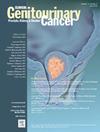神经内分泌前列腺癌真实世界的临床结果和预后因素。
IF 2.3
3区 医学
Q3 ONCOLOGY
引用次数: 0
摘要
背景:神经内分泌前列腺癌(NEPC)包括单纯的NEPC和混合腺癌和神经内分泌组织学的肿瘤。虽然NEPC被认为预后较差,但结果数据稀疏,使得临床医生难以进行风险分层和治疗决策。方法:本回顾性研究在高级别前列腺癌病例的病理检查中发现具有形态学和/或免疫组织化学NEPC特征的患者。中位总生存期(OS)由分期和去势敏感性计算。通过多变量分析评估预后因素。一线转移性全身治疗的OS和无进展生存期也进行了评估。结果:135例NEPC中,25.9%有原始病理报告记录的NEPC。91.9%的病例为混合病理。局限性、非转移性去势敏感、非转移性去势抵抗、转移性去势敏感和转移性去势抵抗前列腺癌的NEPC诊断的中位生存期分别为59.2、42.3、14.3、17.6和9.6个月。贫血(危险比[HR]: 1.66;95% ci 1.05-2.16;P = 0.031),中性粒细胞/淋巴细胞比值(NLR)升高(HR: 1.51;95% ci 1.01-2.52;P = .045),多因素分析显示与死亡风险增加相关。67例患者在雄激素剥夺后接受了一线转移性治疗,中位无进展生存期为5.2个月,生存期为15个月。其中,50.7%接受了1线以上的全身治疗。结论:在病理标本中观察到NEPC的漏诊。与纯腺癌人群相比,NEPC与较差的预后相关,一线转移性治疗进展迅速,后续治疗线之间急剧下降。贫血和NLR升高与生存率低相关。本文章由计算机程序翻译,如有差异,请以英文原文为准。
Real-world Clinical Outcomes and Prognostic Factors in Neuroendocrine Prostate Cancer
Background
Neuroendocrine prostate cancer (NEPC) encompasses pure NEPC and tumors with mixed adenocarcinoma and neuroendocrine histology. While NEPC is thought to confer a poor prognosis, outcome data are sparse, making risk stratification and treatment decisions difficult for clinicians.
Methods
This retrospective study identified patients with morphological and/or immunohistochemical NEPC features on pathological review of high-grade prostate cancer cases. Median overall survival (OS) was calculated by stage and castration sensitivity. Prognostic factors were assessed via multivariate analysis. OS and progression-free survival on first-line metastatic systemic treatment were also evaluated.
Results
Of 135 NEPC cases, 25.9% had NEPC documented in the original pathological report. Mixed pathology was found in 91.9% of cases. Median OS from NEPC diagnosis was 59.2, 42.3, 14.3, 17.6 and 9.6 months for localized, nonmetastatic castration-sensitive, nonmetastatic castration-resistant, metastatic castration-sensitive and metastatic castration-resistant prostate cancer, respectively. Anemia (hazard ratio [HR]: 1.66; 95% CI 1.05-2.16; P = .031) and elevated neutrophil-lymphocyte ratio (NLR) (HR: 1.51; 95% CI 1.01-2.52; P = .045), were associated with increased risk of death on multivariate analysis. 67 patients received first-line metastatic treatment beyond androgen deprivation, with a median progression-free survival of 5.2 months and OS of 15 months. Of these, 50.7% received more than 1 line of systemic treatment.
Conclusion
We observed underdiagnosis of NEPC in pathology specimens. NEPC is associated with poorer prognosis than would be expected in pure adenocarcinoma populations, with rapid progression on first-line metastatic treatment and sharp drop-off between subsequent treatment lines. Anemia and elevated NLR were associated with poor survival.
求助全文
通过发布文献求助,成功后即可免费获取论文全文。
去求助
来源期刊

Clinical genitourinary cancer
医学-泌尿学与肾脏学
CiteScore
5.20
自引率
6.20%
发文量
201
审稿时长
54 days
期刊介绍:
Clinical Genitourinary Cancer is a peer-reviewed journal that publishes original articles describing various aspects of clinical and translational research in genitourinary cancers. Clinical Genitourinary Cancer is devoted to articles on detection, diagnosis, prevention, and treatment of genitourinary cancers. The main emphasis is on recent scientific developments in all areas related to genitourinary malignancies. Specific areas of interest include clinical research and mechanistic approaches; drug sensitivity and resistance; gene and antisense therapy; pathology, markers, and prognostic indicators; chemoprevention strategies; multimodality therapy; and integration of various approaches.
 求助内容:
求助内容: 应助结果提醒方式:
应助结果提醒方式:


